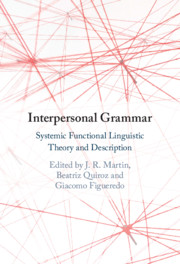Book contents
- Interpersonal Grammar
- Interpersonal Grammar
- Copyright page
- Contents
- Figures
- Tables
- Contributors
- 1 Introduction: Theory and Description in Interpersonal Grammar across Languages
- 2 Interpersonal Grammar in Spanish
- 3 Interpersonal Grammar in Khorchin Mongolian
- 4 Interpersonal Grammar in Mandarin
- 5 Interpersonal Grammar in Tagalog: Assessment Systems
- 6 Interpersonal Grammar of Pitjantjatjara
- 7 Interpersonal Grammar in Brazilian Portuguese
- 8 Interpersonal Grammar in British Sign Language
- 9 Interpersonal Grammar in Scottish Gaelic
- Index
- References
5 - Interpersonal Grammar in Tagalog: Assessment Systems
Published online by Cambridge University Press: 21 May 2021
- Interpersonal Grammar
- Interpersonal Grammar
- Copyright page
- Contents
- Figures
- Tables
- Contributors
- 1 Introduction: Theory and Description in Interpersonal Grammar across Languages
- 2 Interpersonal Grammar in Spanish
- 3 Interpersonal Grammar in Khorchin Mongolian
- 4 Interpersonal Grammar in Mandarin
- 5 Interpersonal Grammar in Tagalog: Assessment Systems
- 6 Interpersonal Grammar of Pitjantjatjara
- 7 Interpersonal Grammar in Brazilian Portuguese
- 8 Interpersonal Grammar in British Sign Language
- 9 Interpersonal Grammar in Scottish Gaelic
- Index
- References
Summary
In this paper we extend work on the interpersonal grammar of Tagalog by focusing on ASSESSMENT resources realised through non-pronominal clitics. From a discourse semantic perspective (Martin & Rose, 2007; Martin & White, 2005), ASSESSMENT is centrally involved in the enactment of ENGAGEMENT, as interlocutors negotiate consensus around propositions and proposals, and the attitudes they inscribe or invoke. The meaning of each assessment clitic is characterised as the basis for the formalisation of this resource in system networks. In addition, the role of assessment clitics in discourse is illustrated through move-by-move analysis of two main texts. The paper concludes with some discussion of SFL’s hierarchy of realisation as far as the description of Tagalog ASSESSMENT resources are concerned.
- Type
- Chapter
- Information
- Interpersonal GrammarSystemic Functional Linguistic Theory and Description, pp. 130 - 159Publisher: Cambridge University PressPrint publication year: 2021
References
- 3
- Cited by



